#plantation in the orchard
Text

Sweetie ~ Chompkyuu
Karasuno ~ Aoba Jhosai




#chompkyuu#plantation in the orchard#haikyuu!!#haikyuu fanart#haikyuu#aoba johsai#seijoh#tsukishima hcs#tsukishima fanart#tsukishima kei#haikyuu tsukishima#tanaka#haikyuu tanaka#tanaka ryuunosuke#haikyuu oikawa#oikawa torū#haikyuu oikawa tooru#oikawa fanart#makki#haikyuu hanamaki#hanamaki takahiro#takahiro hanamaki#fanart#stickers#drawing#digital art#ipaddrawing#illustration#haikyuu karasuno#karasuno
38 notes
·
View notes
Text
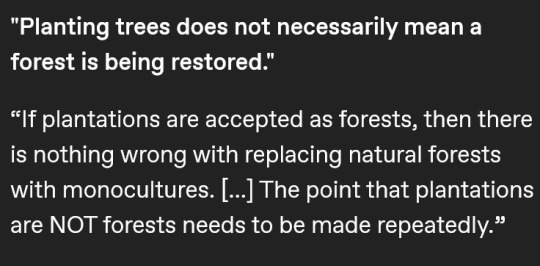
Despite its green image, Ireland has surprisingly little forest. [...] [M]ore than 80% of the island of Ireland was [once] covered in trees. [...] [O]f that 11% of the Republic of Ireland that is [now] forested, the vast majority (9% of the country) is planted with [non-native] spruces like the Sitka spruce [in commercial plantations], a fast growing conifer originally from Alaska which can be harvested after just 15 years. Just 2% of Ireland is covered with native broadleaf trees.
Text by: Martha O’Hagan Luff. “Ireland has lost almost all of its native forests - here’s how to bring them back.” The Conversation. 24 February 2023. [Emphasis added.]
---
[I]ndustrial [...] oil palm plantations [...] have proliferated in tropical regions in many parts of the world, often built at the expense of mangrove and humid forest lands, with the aim to transform them from 'worthless swamp' to agro-industrial complexes [...]. Another clear case [...] comes from the southernmost area in the Colombian Pacific [...]. Here, since the early 1980s, the forest has been destroyed and communities displaced to give way to oil palm plantations. Inexistent in the 1970s, by the mid-1990s they had expanded to over 30,000 hectares. The monotony of the plantation - row after row of palm as far as you can see, a green desert of sorts - replaced the diverse, heterogenous and entangled world of forest and communities.
Text by: Arturo Escobar. "Thinking-Feeling with the Earth: Territorial Struggles and the Ontological Dimension of the Epistemologies of the South." Revista de Antropologia Iberoamericana Volume 11 Issue 1. 2016. [Emphasis added.]
---
But efforts to increase global tree cover to limit climate change have skewed towards erecting plantations of fast-growing trees [...] [because] planting trees can demonstrate results a lot quicker than natural forest restoration. [...] [But] ill-advised tree planting can unleash invasive species [...]. [In India] [t]o maximize how much timber these forests yielded, British foresters planted pines from Europe and North America in extensive plantations in the Himalayan region [...] and introduced acacia trees from Australia [...]. One of these species, wattle (Acacia mearnsii) [...] was planted in [...] the Western Ghats. This area is what scientists all a biodiversity hotspot – a globally rare ecosystem replete with species. Wattle has since become invasive and taken over much of the region’s mountainous grasslands. Similarly, pine has spread over much of the Himalayas and displaced native oak trees while teak has replaced sal, a native hardwood, in central India. Both oak and sal are valued for [...] fertiliser, medicine and oil. Their loss [...] impoverished many [local and Indigenous people]. [...]
India’s national forest policy [...] aims for trees on 33% of the country’s area. Schemes under this policy include plantations consisting of a single species such as eucalyptus or bamboo which grow fast and can increase tree cover quickly, demonstrating success according to this dubious measure. Sometimes these trees are planted in grasslands and other ecosystems where tree cover is naturally low. [...] The success of forest restoration efforts cannot be measured by tree cover alone. The Indian government’s definition of “forest” still encompasses plantations of a single tree species, orchards and even bamboo, which actually belongs to the grass family. This means that biennial forest surveys cannot quantify how much natural forest has been restored, or convey the consequences of displacing native trees with competitive plantation species or identify if these exotic trees have invaded natural grasslands which have then been falsely recorded as restored forests. [...] Planting trees does not necessarily mean a forest is being restored. And reviving ecosystems in which trees are scarce is important too.
Text by: Dhanapal Govindarajulu. "India was a tree planting laboratory for 200 years - here are the results." The Conversation. 10 August 2023. [Emphasis added.]
---
Nations and companies are competing to appropriate the last piece of available “untapped” forest that can provide the most amount of “environmental services.” [...] When British Empire forestry was first established as a disciplinary practice in India, [...] it proscribed private interests and initiated a new system of forest management based on a logic of utilitarian [extraction] [...]. Rather than the actual survival of plants or animals, the goal of this forestry was focused on preventing the exhaustion of resource extraction. [...]
Text by: Daniel Fernandez and Alon Schwabe. "The Offsetted." e-flux Architecture (Positions). November 2013. [Emphasis added.]
---
At first glance, the statistics tell a hopeful story: Chile’s forests are expanding. […] On the ground, however, a different scene plays out: monocultures have replaced diverse natural forests [...]. At the crux of these [...] narratives is the definition of a single word: “forest.” [...] Pinochet’s wave of [...] [laws] included Forest Ordinance 701, passed in 1974, which subsidized the expansion of tree plantations [...] and gave the National Forestry Corporation control of Mapuche lands. This law set in motion an enormous expansion in fiber-farms, which are vast expanses of monoculture plantations Pinus radiata and Eucalyptus species grown for paper manufacturing and timber. [T]hese new plantations replaced native forests […]. According to a recent study in Landscape and Urban Planning, timber plantations expanded by a factor of ten from 1975 to 2007, and now occupy 43 percent of the South-central Chilean landscape. [...] While the confusion surrounding the definition of “forest” may appear to be an issue of semantics, Dr. Francis Putz [...] warns otherwise in a recent review published in Biotropica. […] Monoculture plantations are optimized for a single product, whereas native forests offer [...] water regulation, hosting biodiversity, and building soil fertility. [...][A]ccording to Putz, the distinction between plantations and native forests needs to be made clear. “[...] [A]nd the point that plantations are NOT forests needs to be made repeatedly [...]."
Text by: Julian Moll-Rocek. “When forests aren’t really forests: the high cost of Chile’s tree plantations.” Mongabay. 18 August 2014. [Emphasis added.]
2K notes
·
View notes
Text
A writer’s guide to forests: woodlands made by man
Forests are for the most part, the realm of nature. But what about those with a less than natural origin? Here are some woodlands that are shaped artificially.
Parks and gardens- Trees look nice, there’s no denying it. As long as there have been people who admire trees, there have been gardens and parks. Grassy meadows, neatly trimmed hedges and flower beds may get all the attention, but an accenting grove, or a rambling woodland always adds to the aesthetic. Wealthy aristocrats would import trees from far away places, while more modest landowners and public spaces grow native species. Though the results do look quite natural, they are nonetheless human creations.
Orchard- Fruit and nut bearing trees have always been favored as a reliable source of food. And so people since nearly the beginning of agriculture have been planting orchards to provide for them. Trees are planted in rows, evenly spaced apart for the ease of harvesting. Smaller orchards, those catering to families who pick their own fruit, and those that grow fairly delicate fruits still do the harvesting by hand, while many more rely on machines to do the heavy lifting.
Tree farm/ plantation- Many trees types cultivated are deciduous species, but there are some instances when conifers are preferred. Being relatively fast growing, and usually possessing a single, straight trunk, they are the ideal tree type for use as lumber and paper products. Of course, one cannot forget the need every November and December for Christmas trees.
Palm plantation- The tropics are ideal for growing oil palms. Thousands of acres are devoted to the tree, as so much of our food and other products these days relies on palm oil. This is not a good thing as the demand means that vast areas of rainforest have had to be cleared. In Indonesia, the problem is particularly evident, as the growth of palm plantations is one of the main factors behind the decline of orangutan numbers.
Coconut grove- Almost anywhere you go in the tropics will have coconut palms. Buoyant, the nut floats easily on the currents, and where it is too isolated for a coconut to reach naturally (such as Hawaii), people have brought it with them. As well as the coconuts, the palms themsevles are also used; palm fronds can be used for roofing, and the fibers are used in weaving.
Bonsai forest- The art of growing miniature trees has been practiced for centuries. Some trees are collected in the wild, harsh natural conditions causing the trees to grow slowly and stay small, but many more are shaped over many years. While many bonsai are grown singularly, groves and forests are also popular choices. These can be either monospecific, or mixed, and can be part of a larger landscape creation that includes rocks, water, and figures.
There are plenty of examples of forest areas that are man-made. Don’t feel like you have to confine your story to a natural woodland. Use what you find around you to inspire the setting and drive your characters and the plot. What happens on the earth can easily be applied to science fiction or fantasy. Put your own spin on it (maybe your characters are small and live in a bonsai forest…of course they could also be normal sized people who happen to be in a giant sized bonsai planting).
Edit: As pointed out in the comments/reblogs, I seemed to have forgotten woodlots, so I am going to include those.
Woodlot- Common areas open to members of the community include a mixture of open pastureland and forested areas. People would have their flocks and herds forage here in spring and summer, whilst they managed and harvested the trees. Trees in woodlots would not be felled, instead the branches would be cut back and allowed to regrow. The resulting growth produces straight branches that are used in constructing walls, fences, as well as firewood and charcoal. (Communal pastures and woodlots are not really thought of these days, as many areas were lost over the years due to industrialization, urbanization, and the enclosure of land by the aristocracy)
#writing#creative writing#writing guide#writing inspiration#writing prompts#worldbuilding#writer#writers#writers and poets#writing community#writer on tumblr#writeblr
56 notes
·
View notes
Text
The success of forest restoration efforts cannot be measured by tree cover alone. The Indian government’s definition of “forest” still encompasses plantations of a single tree species, orchards and even bamboo, which actually belongs to the grass family.
This means that biennial forest surveys cannot quantify how much natural forest has been restored, or convey the consequences of displacing native trees with competitive plantation species or identify if these exotic trees have invaded natural grasslands which have then been falsely recorded as restored forests.
Natural forest regeneration and plantations for timber and fuel should both be encouraged, but with due consideration of how other ecosystems and people will be affected. This includes carefully choosing plantation species to ensure they don’t become invasive.
The objective of increasing tree cover should be assessed in terms of its implications for forest rights, local livelihoods, biodiversity and carbon storage.
70 notes
·
View notes
Text
Taman Simalem is a retreat for the senses. 1,200 metres above sea level, the cool, crisp air immediately sets you at ease and the stunning view of Lake Toba just takes your breath away
This mountain resort was built to create a new and unique way to live holistically, with its organic farms and fruit orchards, tea and coffee plantations, and various accommodations that allow a commune with nature. Feel recharged, revitalised and renewed.

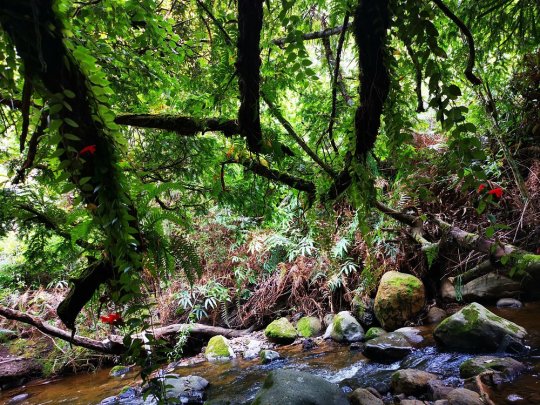



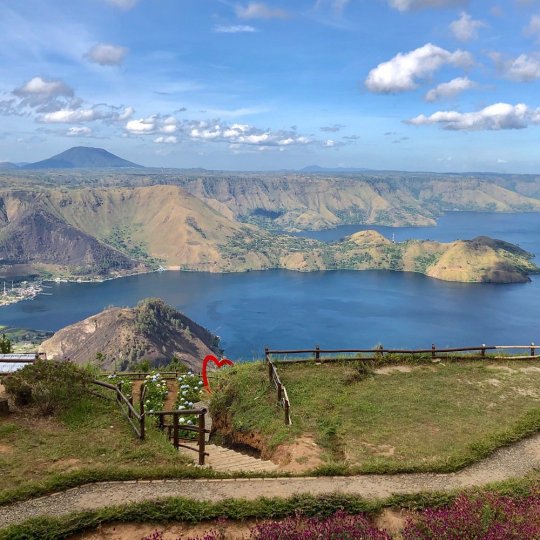

#positive mental attitude#positive#positive thoughts#bemindful#mindfulness#health & fitness#selfcare#retreat#vacation#indonesia
11 notes
·
View notes
Note
Hi, I’m doing a project for my Environmental Science class critiquing the modern white vegan movement and I was wondering if you had any resources to share or blogs to follow? It’s been hard to sift through the internet search results and I noticed this is something you discuss sometimes.
@scoutandcowpany may be better to ask since you clarified in another ask you were primarily wanting statistics on sustainability and such.
What I advise looking up is the DDT crisis in North America that nearly killed the peregrine falcon and bald eagle off, pesticides and pesticide-resistant mutated crops are major issues for the environment and human health. You can find scientific papers regarding pyrethroids and other families of chemicals still used today in crops. The structure of human digestive tracts are very comparable to that of a pig’s, a very notoriously omnivorous animal and there are papers supporting the fact humans can process animal byproducts more easily than they can plants. In general the amount of water used in crop farming and the INCREDIBLY CONCERNING depletion of the soil due to many farms growing the same monoculture year after year. I also reblogged a post the other day about how studies showed bison reintroduction increased the health of a grassland or prairie habitat by 90%, while normal cattle still increased it by about 30%. Corn could never.
Oh, and you can look for articles discussing the slave labor of undocumented workers in America on plantations and orchards. I would say you can also bring examples of vegan sites making bold claims about animal agriculture that are very easily verified as false.
170 notes
·
View notes
Text




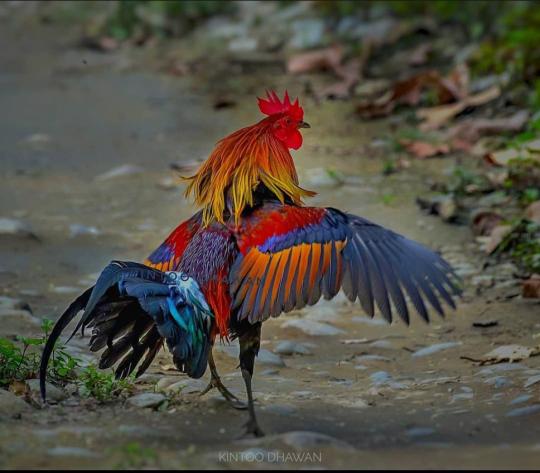
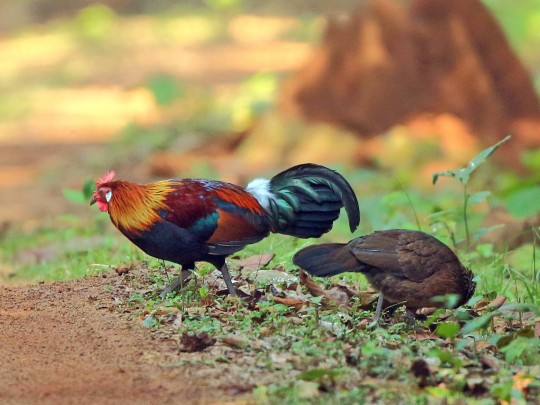


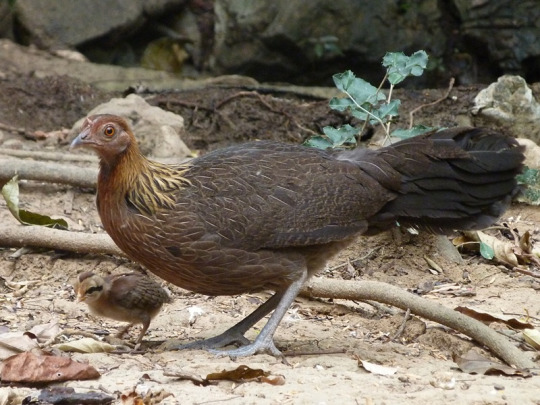

Gallus gallus better known as the red jungle fowl, the bankiva, the wild chicken, or the bankiva fowl, is a species of tropical bird in the family Phasianidae which is native throughout much of south east asia from India, Nepal and Bangladesh in the west, and eastwards across southern China, to Indochina; south/southeast into Malaysia, Singapore, the Philippines, and Indonesia. Red junglefowl are also the primary wild ancestor of the various breeds of domestic chickens, with humans first keeping and domesticating these birds some 8,0000 years ago. As such like its domestic descendants, was brought with and introduced to various regions across the world most notably Micronesia, Melanesia, Australia, and Polynesia. Here they inhabit all range of forests and woodlands as well as plantations, orchards, and agricultural areas. They live in flocks consisting of a few roosters and several hens and there offspring, often lead by a dominant male who maintains a small territory often centered around ideal roosting spots. They feed upon fruit, seeds, insects and other invertebrates, grains, leaves, stems, bamboo, grasses, roots, tubers, and the occasional small rodent or lizard. Jungle fowl are in turn eaten by a plethora or predators including various cats, civets, canines, primates, hyenas, lizards, snakes, crocodilians, coconut crabs, bears, marsupials, and predatory birds. Female red jungle fowl typically reach around 2.25lbs (1kg) in weight and 17 inches (43.2 cms) in length, while males can get to about 3.25 (1.5kg) in weight and 30 inches (76.2cms) in length. The males coloration is a vibrant mix of orange, brown, red, gold, grey, white, olive and even metallic green feathers. In contrast females are typically much more muted in plumage. Males also sport a long tall and larger combs and wattles than females. Flight in these birds is almost purely confined to reaching their roosting areas at sunset in trees or any other high and relatively safe places free from ground predators, and for escape from immediate danger through the day. Breeding occurs in the dry season, during which time males impress females by performing a display called "tidbitting" in which they dance, call, bobble, and brings the female food. After mating the female will lay an egg a day, for up to 12 days, and incubate them for 21 days until hatching. The young fledge at around 5 weeks of age, and at 12 weeks they are forced out of there mothers flock and must set off to join another or form there own. Under ideal conditions a red jungle fowl will reach sexual maturity at around 5 months of age and may live up to 30 years.
#pleistocene pride#pleistocene#pliestocene pride#pliestocene#cenozoic#ice age#stone age#dinosaur#bird#red#jungle#fowl#red junglefowl#junglefowl#chicken#asia#polynesian
7 notes
·
View notes
Text

The Restless Spirits at Waverly Plantation
A loving husband had this unique Southern plantation home designed and built for his wife in the mid-1800s. But she tragically died, before Waverly Mansion, located in Clay County Mississippi was finished.
George Hampton Young was a colonel who moved from Georgia to Mississippi to establish a cotton plantation along the Tombigbee River.
Young and his ten children moved into their new home in the 1850s. He ran an impressive farm.
Waverly, besides providing large quantities of cotton had a tannery, lumber mill, gristmill, brick kiln, ice house, gardens, orchards and livestock. The plantation also manufactured its own gas, which was piped into the house to illuminate it.
Waverly has a unique architectural feature, not often seen in the South, a massive copula sits atop this home that affords the visitor a 360-degree view of the surrounding countryside.
This mansion also is known as one of the most haunted homes in the South.
The Young family maintained Waverly until the last of the ten children died in 1913. It then was left to slowly deteriorate.
Robert and Donna Snow fell in love with the old house and spent several years in the 1960s, restoring it to its original splendor. It was made a National Historic Landmark in 1973.
During this time, the Snow’s became acquainted with an assortment of ghosts that haunt Waverly.
The home today is run as a house museum.
During the Civil War several Confederate officers, friends of the Young family, recuperated from battle wounds at Waverly.
In one mirror from this period, a strange sight is seen. Visitors report a Confederate soldier standing behind them, only to turn around and find no one is there.
Colonel Young’s wife, who never lived in the house, is observed wandering through the second-floor rooms. She turns and stares at visitors and then slowly disappears.
The Colonel himself is seen riding a phantom horse near the family cemetery. He is also seen walking through this graveyard and in the yard near the mansion.
The most active ghost at the plantation has been seen and heard by many tour guides and visitors.
This four-year-old girl is believed to be the daughter of a Young family friend. Her apparition appears so real that visitor’s on tours have tried to find what adults she belongs to.
She is usually spotted on the landing of the spiral staircase between the second and third floors.
It is believed that she died of diphtheria in the home during the Civil War.
This young ghost is also heard crying for her mother.
Another sound often noted involves many voices attending a dinner party. They are heard laughing and enjoying music in the mansion’s ballroom.

#The Restless Spirits at Waverly Plantation#waverly plantation#haunted plantations#ghost and hauntings#paranormal#ghost and spirits#haunted locations#haunted salem#myhauntedsalem#paranormal phenomena#supernatural#spirits#ghosts#hauntings
6 notes
·
View notes
Text
ttrpg classes based on filipino products and culture.
MANGO CLERIC: You grew up in a monastery surrounded by mango orchards. Fruitsong and honeywisdom - you harness the mangos’ metaphysical sweetness to heal your allies.
COFFEE BARBARIAN: You stopped eating solid food a while back. Coffee flows through your veins. You’re always this close to going on a rampage.
SUGAR WARLOCK: You entered a contract with the god of your family’s sugar plantation. Giving up your life of ostentation, you’ve dedicated yourself to protecting the oppressed.
TUNA ROGUE: You’re as slippery as the fish port you worked in. Weaving in and out of places, just like the tuna you smuggle.
BEATA PALADIN: Mercy and miracles go hand in hand. You swore an oath of poverty to the Almighty, giving you the power of the santos.
BAKYA FIGHTER: You grew up on the streets. Those who underestimate your slippers won’t know what hit them.
COCONUT DRUID: Coconuts are as old as creation itself. You harness their energy as the Trees of Life - “sky above and below, with water in between” as the riddle goes.
BANDURRIA BARD: A bottle of tuba and a string instrument are all you need. You croon the old melodies, of loves lost and torn asunder. Heartbreak flows through your singing.
SQUID WIZARD: The squid-ink scribblings of old are long gone - or so the conquistadores thought. The inkbearers remember, and have passed their knowledge to you.
13 notes
·
View notes
Text




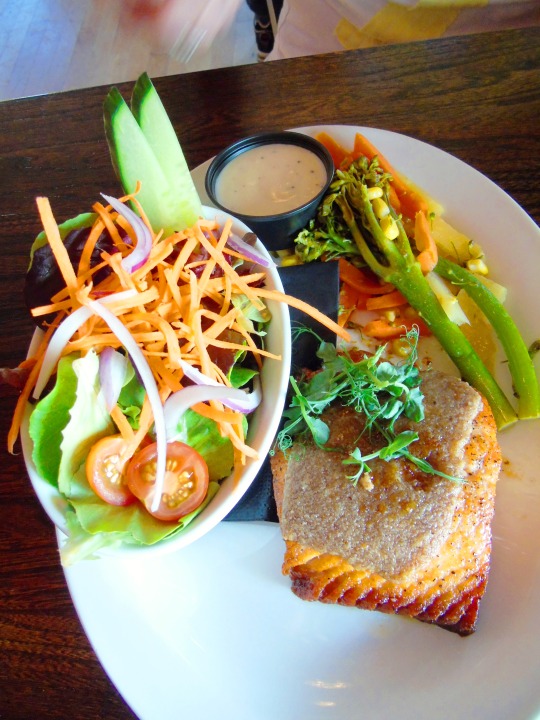






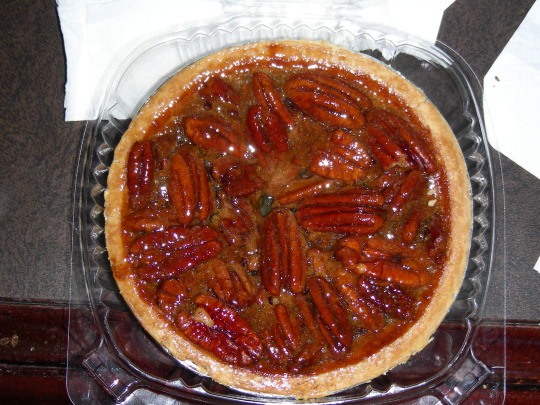



National Pecan Day
On April 14, we celebrate National Pecan Day, pecan — a uniquely American nut whose fan base counts the likes of founding fathers such as George Washington and Thomas Jefferson. Whether it’s a garnish on a salad or a stand-alone snack, caramelized or roasted, sweet or savory — pecans never fail to deliver on the enthralling taste and the ultimate nutrient density. Did you know, America is credited for 75% of the world’s total pecan production? This fun holiday was established by the National Pecan Shellers Association in 1966 to recognize and honor the workforce behind the cultivation of pecans in America.
History of National Pecan Day
On National Pecan Day, America celebrates the only nut native to its land. Pecans are a much-celebrated nut of America, used in deserts, icecreams, and snacks.
Centuries before European colonization, pecans were cultivated, processed, and consumed in America by Native people. The word ‘pecan’ is derived from the word ‘pacane,’ used by the Algonquin tribe to describe a nut that needs a stone to crack open. The tribes valued pecan for its nutrition density, availability, ease of consumption, and fulfilling taste.
In the late 17th century, the native nut caught the eye of Spanish colonists, who began cultivating large pecan orchards in the vicinity. But it wasn’t until the 18th century that the commercialization of pecans picked up the pace in the United States. By 1802, formal selling routes were established, and pecan export had commenced.
In 1882, a hybrid fruit via the budding of pecan and an adjacent wild plant was created by Abner Landrum, a cultivator from South Carolina. This resultant nut was considered to be an upgraded version of pecan. Although the hybrid seeds of Abner got lost in time, in 1876, the process of grafting was recreated by Antoine, a slave from Louisiana. Antoine presented his discovery at the Philadelphia Centennial Exposition in 1976 and thus began farming a new and improved variety of pecans throughout the country.
Today, America is responsible for three quarters of pecan production in the world. From the summer lanes of Texas to the sunny pavements of California, pecan cultivation is a year-long endeavor for thousands of American farmworkers.
In 1996, the National Pecan Shellers Association members came together to establish April 14 as National Pecan Day. The objective of the day is to celebrate the earthly wonders of this nut and to uplift the hardworking members of the industry who make the sustainable farming of pecans possible.
National Pecan Day timeline
1772 The First Plantation
Long Island farmers organize the first pecan plantation of pecan trees, propagating safe and easy ways of pecan plantation.
1775 George Washington’s Imprint
Founding Father George Washington plants a pecan tree in Mount Vernon, symbolizing the rapid popularity of pecans in America.
1943 Formalization
National Pecan Shellers Association is established to represent thousands of pecan farmers and shellers across the country
1996 Establishment of the Day
The National Pecan Shellers Association establishes National Pecan Day to honor the native nut of America.
National Pecan Day FAQs
How is 'pecan' pronounced?
The correct pronunciation of pecan is PEE-can. However, a majority of southern Americans like to say it as PA-kawn. How do you pronounce it?
Are pecan and walnut the same thing?
It’s easy to get confused, but walnuts and pecans are two different nuts from the same Junlandacea family. Walnut has a smooth exterior with a lighter color, unlike pecans, which have a chocolate brown color with definitive lines.
Can you eat pecan raw?
Yes! Pecans, like all other nuts, are edible in their raw form. You can carry a couple of these shelled nuts in your pocket to munch through the day, or you can scatter them on your salad for that extra crunch.
National Pecan Day Activities
Plan a pecan day
Host a bake off
Plant a pecan tree in your backyard
Indulge in the versatile offering of this great American nut by planning your menu around it. Start the day with fluffy pecan pancakes, then have butter pecan chicken for lunch. For a midday snack, enjoy a couple of candied pecans, and end your day with pecan-crusted salmon and some hot pecan pie.
From cookies to pies, pecans go well with any baking dish. So for National Pecan Day, host a bakeoff with your friends and family — featuring our beloved pecans.
Pecans are non-fuss plants that don’t require a liver and a half to take sapling. Plant the seeds today, so you can reap the nuts tomorrow.
5 Important Facts About Pecans
It’s a vitamin party
It’s more than a crunch
A friend to the heart
A love for centuries
A dose of pecan for Apollo
Pecans are home to 19 different vitamins and minerals, including vitamin A, vitamin E, magnesium, and potassium.
Pecan oil, processed from pecans, is recommended for those with a risk of heart disease.
Pecans have the official certification of the American Heart Association for being a ‘Heart-Healthy Food.’
A pecan tree grows to over 150 feet tall and lives for over 300 years.
Astronauts carried pecans to the moon in their Apollo space mission twice.
Why We Love National Pecan Day
Pecans are underrated
Pecans are the O.G. American nut
Pecans contribute to the economy
The sweet and crunchy texture of a pecan elevates any dish it touches. Be it candies, cookies, bread, pie, salads, or ice cream. It’s time we honor the contribution of this humble nut in our kitchen and celebrate National Pecan Day with full excitement.
While cashew came to America from Brazil and the California almonds are actually a gift of Spain, pecan is the singular nut native to America. Pecans were widely consumed by native Americans before European colonization.
The American pecan industry is worth over $3.5 billion. Just 15 states of the U.S. produce more than 75% of pecan of the world. The pecan trees are responsible for the livelihoods of thousands of families and a flourishing U.S. economy
Source
#Pecan Praline Milkshake#Pecan Caramel Brownie#Pecan Pie#travel#USA#Pecan Crusted Chicken and Waffles#Pecan Pie a la Mode#dessert#entréé#pecan crusted fresh salmon#Canada#original photography#vacation#food#bakery#restaurant#Chris' Outrageous Cheesecake#Caramel Pecan Turtle Cheesecake#Chocolate Pecan Pie#Butterscotch-Pecan Pancakes#National Pecan Day#14 April#NationalPecanDay
2 notes
·
View notes
Text
Soft squad ~ 1 Sucrose

Just thinking of some cut out icons of the genshin animal-like characters
#plantation in the orchard#icon#genshin icons#anime icons#sucrose#genshin impact#genshin fanart#genshin#genshin sucrose#genshin impact sucrose#sucrose genshin impact#mondstadt#fanart#digital art#illustration
6 notes
·
View notes
Text
Planting trees does not necessarily mean a forest is being restored.
---
But efforts to increase global tree cover to limit climate change have skewed towards erecting plantations of fast-growing trees. The reasons are obvious: planting trees can demonstrate results a lot quicker than natural forest restoration. This is helpful if the objective is generating a lot of timber quickly or certifying carbon credits which people and firms buy to supposedly offset their emissions. [...] [I]ll-advised tree planting can unleash invasive species [...]. For more than 200 years India has experimented with tree plantations, offering important lessons about the consequences different approaches to restoring forests have on local communities and the wider environment. This rare long-term perspective should be heeded [...].
Britain extended its influence over India and controlled much of its affairs [...] from the mid-18th century onwards. Between 1857 and 1947, the Crown ruled the country directly and turned its attention to the country’s forests. Britain needed great quantities of timber to lay railway sleepers and build ships in order to transport the cotton, rubber and tea it took from India.
Through the Indian Forest Act of 1865, forests with high-yielding timber trees such as teak, sal and deodar became state property. To maximise how much timber these forests yielded, British colonial authorities restricted the rights of local people to harvest much beyond grass and bamboo. [...] Meanwhile plantations of teak (Tectona grandis), a species well adapted to India’s hot and humid climate and a source of durable and attractive timber, spread aggressively. [...]
---
[G]rasslands and open scrub forest gave way to teak monocultures.
Eucalyptus and other exotic trees which hadn’t evolved in India were introduced from around 1790. British foresters planted pines from Europe and North America in extensive plantations in the Himalayan region as a source of resin and introduced acacia trees from Australia for timber, fodder and fuel.
One of these species, wattle (Acacia mearnsii), first introduced in 1861 with a few hundred thousand saplings, was planted in the Nilgiris district of the Western Ghats. This area is what scientists all a biodiversity hotspot – a globally rare ecosystem replete with species. Wattle has since become invasive and taken over much of the region’s mountainous grasslands.
Similarly, pine has spread over much of the Himalayas and displaced native oak trees while teak has replaced sal, a native hardwood, in central India. Both oak and sal are valued for fuel, fodder, fertiliser, medicine and oil. Their loss [...] impoverished many.
---
India’s national forest policy [...] aims for trees on 33% of the country’s area. Schemes under this policy include plantations consisting of a single species such as eucalyptus or bamboo which grow fast and can increase tree cover quickly, demonstrating success according to this dubious measure. Sometimes these trees are planted in grasslands and other ecosystems where tree cover is naturally low. The result is that afforestation harms rural and indigenous people who depend on these ecosystems [...].
In the Kachchh grasslands of western India communities were able to restore grasslands by removing the invasive gando bawal (meaning “mad tree”) first introduced by British foresters in the late 19th century. [...]
The success of forest restoration efforts cannot be measured by tree cover alone. The Indian government’s definition of “forest” still encompasses plantations of a single tree species, orchards and even bamboo, which actually belongs to the grass family. This means that biennial forest surveys cannot quantify how much natural forest has been restored, or convey the consequences of displacing native trees with competitive plantation species or identify if these exotic trees have invaded natural grasslands which have then been falsely recorded as restored forests. [...]
Planting trees does not necessarily mean a forest is being restored. And reviving ecosystems in which trees are scarce is important too.
---
Text by: Dhanapal Govindarajulu. "India was a tree planting laboratory for 200 years - here are the results." The Conversation. 10 August 2023. [Bold emphasis, some paragraph breaks/contractions, and italicized first line in this post added by me.]
141 notes
·
View notes
Text
Jonny as a wandering soul, a traveler, who went from his hometown in Winnipeg off to college in North Dakota, did a stint in Mexico building houses and that was it, he was gone, the call of the wild world luring him in. He lives everywhere exactly a year, digging wells in Ethiopia, shearing sheep in Australia, working on a coffee plantation in Bali, teaching folks how to surf in Costa Rica, living in an ashram in India. Getting to know the people, the local customs, living his best life. Doing it all for a year, a full cycle, all the seasons and the celebrations, the ups and downs, and then he moves on.
He's just arrived in Chicago working in a pizza restaurant even though he's gluten-free, working dough all day, standing at the giant oven in full view of the patrons, white shirt clinging to his forearms, giant forehead glistening under his white paper cap as he rotates pies in and out of the oven.
Patrick, of course, is instantly smitten, getting elbowed by Sharpy and Shawzy more than once when he can't stop staring at this hunk of a man working the counter today, throwing on cheese with a flick of his wrists that has Pat sweating. Takes him all meal to gather up the courage to sidle up to Jonny at the end of the night while Shawzy and Sharpy watch from the door, Jonny wiping down the counter, Pat's own palms sweaty.
"How long, uh, have you been making pizzas?" God, Pat is the lamest human being on earth.
Jonny looks up, surprised, like he didn't expect Pat to actually gather his courage and speak to him. He musters Pat with dark eyes before his lips quirk up in a tiny smirk. "Two days."
"Two days?!" Pat is getting his leg pulled here. No way did Jonny only learn that two days ago.
Jonny looks smug, flattered by Pat's incredulousness, eyes twinkling like he's laughing at Patrick. "I just got here."
They hit it off. Pat shows Jonny around, to millennium park taking goofy selfies in the bean, takes him to a hockey game even though the Hawks suck but the tickets are cheap, eats more pizza than he has in decades. Jonny is fascinating, full of stories, full of thoughts on life, on spirituality and what it means to be alive, how to do good, speaks with such quiet intensity Pat can't help but hang on every word, his own measly life as an accountant suddenly feeling small and pale in comparison to Jonny's wild stories.
Jonny's pan, because you can't wander the world without opening your mind to all the beautiful people out there (his words, not Pat's), and when he kisses Pat, hand rough with callouses resting lightly on Pat's cheek, Pat's gone hook, line, and sinker.
They all but move in together, Sharpy teasing Pat relentlessly how everything's 'Jonny, Jonny, Jonny' these days, Pat's cheeks blushy when Sharpy smiles and claps him on the back. "You look happy, Peekaboo."
Jonny's hot and funny and so very good with his hands. Pat's in love.
And then Jonny tells him, casual, the two of them curled up on the bed of Jonny's pickup truck, blanket and Jonny's thick arm wrapped around him because Pat gets cold, apples from when they went picking them in the orchard earlier spilling out of the Ikea bags they used to collect them in (Jonny wants to make juice, Pat came for the free food), watching the stars because Jonny is a closet romantic like that, loudly musing where else he wants to go next. Pat's suddenly cold in a way that has nothing to do with the outside temperature, heart heavy in his chest.
They have a year.
31 notes
·
View notes
Text
December 5th, 2023

Wisley Webspinner (Aposthonia ceylonica)
Distribution: Usually found in tropical regions of Asia and Africa, including Madagascar, Mauritius, India, Sri Lanka, Malaysia, Laos and Thailand.
Habitat: Found on the bark of deciduous and coniferous trees or on the hanging roots of tropical plants; present in forests, parks, plantations and orchards.
Diet: Larvae and female adults are herbivorous; males do not eat.
Description: A. ceylonica is a species belonging to the order Embioptera, better known as webspinners. These insects have silk glands on their forelegs, allowing them to create silk galleries. These nests serve two purposes: protecting the webspinners from predators, and reducing the chance of being swept away by the heavy rains and winds typical of their tropical environment. Despite fasting, males of this species also produce silk.
This species gained some notoriety in 2019, when a small population was found colonizing a warm greenhouse in the Royal Horticulture Society's garden in Surrey, England. Its introduction marked the first new order of insects found in the UK since 1909. Due to their tropical distribution, these webspinners are limited to the greenhouse and would very likely perish if they were to venture outside, meaning there's little risk of them becoming an invasive species in the region.
(Image by Sebastian Büsse)
4 notes
·
View notes
Text
Dionysus, the god of the grape-harvest, wine making, orchards and fruit, vegetation, fertility, festivity, insanity, ritual madness–!
Oh, they both are idiots.

Say hi to the Dionysus brothers!
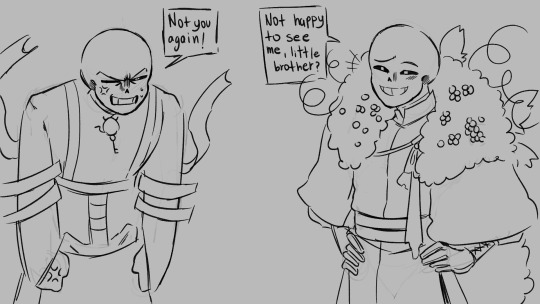
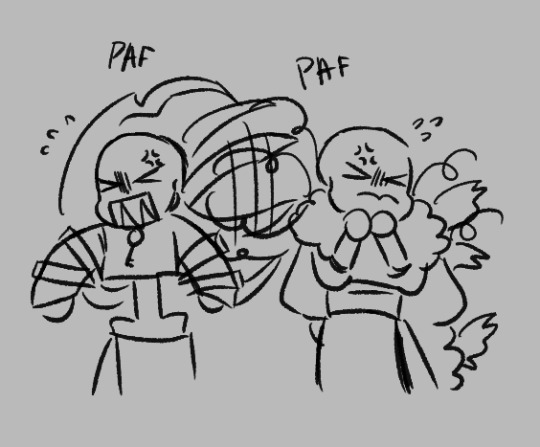
They're pathetic.

Grape!Sans, one of the office bearers of Dionysus, the God of festivities, insanity, fruit and fertility.
Grape is a good-for-nothing guy, full of himself with a gigantic ego, an amazing sword fighter who takes care of the great grape plantations.
He was an adopt I got from @maxsparkles and did the redesign! Thank you, I love him very much
Grape!Sans belongs to me
Wine!Sans belongs to @s3ar3d-h3art
9 notes
·
View notes
Text
Greening disease spike has Brazilian orange growers on alert
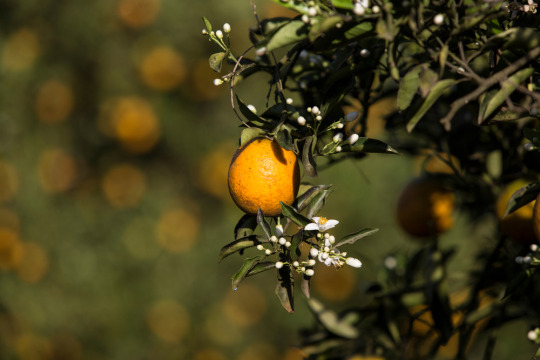
Data from the Citrus Producers’ Defense Fund (Fundecitrus) shows a 56 percent spike in the presence of greening disease in Brazil’s citrus belt — which straddles the states of São Paulo and Minas Gerais.
The incidence of greening disease has increased in each of the past six years, jumping from 24 percent in 2022 to 38 percent this year. It was the largest percentage increase since 2008.
Brazil reserves about 800,000 hectares for orange plantations, being the country’s largest fruit crop. The country accounted for 38 percent of orange juice exports in 2021, according to the Observatory of Economic Complexity.
One of the main causes of the spread of greening, according to Fundecitrus, has been the practice of keeping diseased trees in commercial orchards, especially in production, with insufficient control of the plant-feeding insects — greening has become more and more resistant to pesticides.
Continue reading.
2 notes
·
View notes